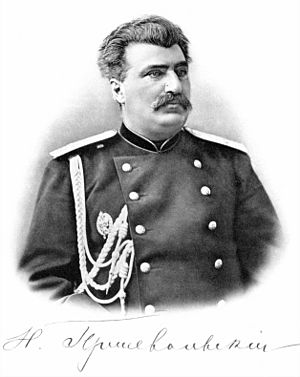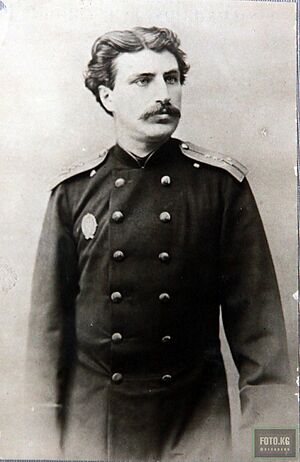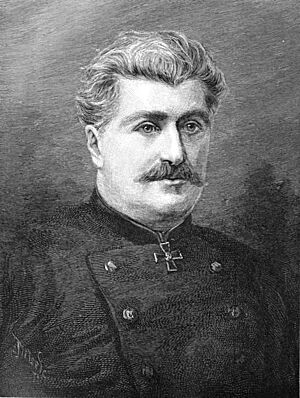Nikolay Przhevalsky facts for kids
Quick facts for kids
Nikolay Przhevalsky
|
|
|---|---|
 |
|
| Born |
Nikolay Mikhaylovich Przhevalsky
April 12, 1839 Kimborovo, Smolensky Uyezd, Smolensk Governorate, Russian Empire
|
| Died | November 1, 1888 (aged 49) Karakol, Russian Empire (now Kyrgyzstan)
|
| Nationality | Russian |
| Occupation | explorer, geographer |
| Known for | exploration of Central Asia |
| Awards | Vega Medal (1884) |
Nikolay Mikhaylovich Przhevalsky (born April 12, 1839 – died November 1, 1888) was a famous Russian explorer and geographer. He was known for his many journeys through Central and East Asia.
Even though he never reached his main goal, the city of Lhasa in Tibet, he explored many areas that were unknown to people in the West. These included northern Tibet, Amdo (now Qinghai), and Dzungaria (now northern Xinjiang). His travels greatly increased Europe's knowledge of Central Asian geography.
He also described several animal species that were new to European science. These include Przewalski's horse, Przewalski's gazelle, and the wild Bactrian camel. Today, all these animals are endangered. Przhevalsky was also a mentor to his student, Pyotr Kozlov.
Contents
Biography: Early Life and First Expedition
Nikolay Przhevalsky was born in Kimborovo, a village in the Russian Empire. He came from a Polish noble family. He studied in his hometown and later at a military academy in Saint Petersburg. In 1864, he became a geography teacher at a military school in Warsaw.
In 1867, Przhevalsky asked the Russian Geographical Society to send him to Irkutsk in central Siberia. He wanted to explore the Ussuri River basin. This river is a major branch of the Amur River, located on the border between Russia and China. This was his first important expedition. It lasted two years. After returning, Przhevalsky wrote a book about his journey called Travels in the Ussuri Region, 1867–69.
His most famous student was Pyotr Kozlov. Kozlov later discovered the ruins of the ancient city of Khara-Khoto. This city belonged to the Tangut people and was located in western Inner Mongolia.
Exploring Central Asia: Przhevalsky's Journeys
After his first expedition, Nikolay Przhevalsky made four more long journeys into Central Asia. These trips helped people learn a lot about the region.
First Major Journey (1870–1873)
Przhevalsky started from Kyakhta and crossed the Gobi Desert to Beijing. He then explored the upper Yangtze River and traveled into Tibet in 1872. During this trip, he mapped over 7,000 square miles of land. He also collected many samples: 5,000 plants, 1,000 birds, 3,000 insects, 70 reptiles, and skins from 130 different mammals. For his achievements, he received the Constantine Medal and was promoted in the military.
This journey also gave important information to the Russian military. There was a Dungan Revolt (1862–77) happening in China at the time. Przhevalsky's reports helped them understand the situation.
Second Journey (1876–1877)
This expedition took Przhevalsky through East Turkestan and over the Tian Shan mountains. He visited what he thought was Qinghai Lake. It was believed that no European had seen this lake since Marco Polo. The expedition had ten men, twenty-four camels, and four horses. They carried three tons of supplies. However, the group faced problems with illness and poor camels. They later got better camels and more supplies, including ammunition and food. They tried to reach Lhasa but were not successful.
Third Journey (1879–1880)
Przhevalsky's third journey went through Hami and the Qaidam Basin to Qinghai Lake. The team then crossed the Tian Shan mountains into Tibet. They got within 260 kilometers of Lhasa. However, Tibetan officials stopped them from going further, and they had to turn back.
Fourth Journey (1883–1885)
This final major journey began in Kyakhta. Przhevalsky and his team crossed the Gobi Desert to Alashan and the eastern Tian Shan mountains. They turned back at the Yangtze River. The expedition then returned to Qinghai Lake. From there, they traveled west towards Hotan and Issyk Kul.
The results of these journeys greatly advanced the study of Central Asian geography. They also helped scientists learn about the animals and plants in this huge region. Many of these were unknown to Western scientists before Przhevalsky. He described Przewalski's horse and Przewalski's gazelle, which are named after him. He also described what was then thought to be a wild group of Bactrian camels. Later, scientists found that the Wild Bactrian camel is a separate species from the domestic one.
Przhevalsky wrote five major books in Russian. Two of his books were translated into English: Mongolia, the Tangut Country, and the Solitudes of Northern Tibet (1875) and From Kulja, Across the Tian Shan to Lob-Nor (1879). The Royal Geographical Society gave him their Founder's Medal in 1879 for his important work.
Przhevalsky's Legacy and Death
Nikolay Przhevalsky died from typhus in 1888. This happened just before he was about to start his fifth journey. He died in Karakol, a town on the shore of Issyk Kul in what is now Kyrgyzstan. He likely caught the disease from the Chu River. The Tsar, Russia's ruler, immediately changed the town's name to Przhevalsk in his honor.
There are monuments to Przhevalsky in Karakol and a museum about his life and work. Another monument stands in Saint Petersburg.
Less than a year after Przhevalsky's death, Mikhail Pevtsov took over his expedition into Central Asia. Przhevalsky's work was also continued by his young student, Pyotr Kozlov.

Another place named after Przhevalsky is a village in Smolensk Oblast, Russia. He lived there from 1881 to 1887, except when he was traveling. He loved the village, and it was renamed Przhevalskoye in 1964. There is a memorial complex there with his old and new houses, a bust, a pond, and gardens. This is the only museum about the famous traveler in Russia.
Many plants and animals are named after Przhevalsky. A genus of flowering plants from Asia, Przewalskia, was named after him. More than 80 plant species also carry his name. Five species of lizards are named in his honor: Alsophylax przewalskii, Eremias przewalskii, Phrynocephalus przewalskii, Scincella przewalskii, and Teratoscincus przewalskii.
Przhevalsky's Views and the Great Game
Some historians say that Przhevalsky's books about Central Asia showed his dislike for some Asian cultures, especially Chinese civilization. He sometimes described Chinese people in a negative way. He also believed that China's control over its northern areas, like Xinjiang and Mongolia, was weak. Przhevalsky openly suggested that Russia should take parts of China's land. He once said that one should explore Asia "with a carbine in one hand, a whip in the other."
Przhevalsky, along with other explorers like Sven Hedin and Aurel Stein, played a role in the "Great Game." This was a political struggle between the British and Russian Empires. Both empires wanted more influence and control in Central Asia during the 19th century.
Przhevalsky also had strong opinions about other non-Chinese Asian groups. He described the Tajik leader Yaqub Beg as "feckless." Przhevalsky claimed that the Muslim people in Kashgar disliked their government and wanted to become Russian subjects. He suggested that Russian troops should take over the Kashgarian area. However, the Russian government did not act on this, and China later regained control of Kashgar. Przhevalsky's ideas about taking land from China did not come true.
Przhevalsky believed that the millions of non-Chinese people in Tibet, Turkestan, and Mongolia were not as developed. He thought they needed to be freed from Chinese rule. He even suggested that Russia should encourage Buddhist and Muslim groups in these areas to rebel against China. He proposed that Russia could start a war with China and, with a small number of troops, take control of Turkestan.
Personal Life: Relationships
Przhevalsky was known to have a special relationship with Tasya Nuromskaya. He met her in Smolensk. A story says that during their last meeting, she cut off her braid and gave it to him. She said the braid would travel with him until they got married. Sadly, she died from sunstroke while Przhevalsky was on an expedition.
Another woman in Przhevalsky's life was a mysterious young lady. Her portrait and a poem were found in his album. In the poem, she asked him to stay with her and not go to Tibet. Przhevalsky wrote in his diary that he would never betray the ideal to which his life was dedicated. He said he would return to the desert, where he would be much happier than in "gilded salons" that could be gained through marriage.
Works
- General N. M. Prjevalsky (1887). "On new Species of Central-Asian Birds". The Ibis 5. https://archive.org/details/ibis55brit/.
Film
- A 1951 Soviet drama film tells the story of Przhevalsky's life and work.
See also
 In Spanish: Nikolái Przewalski para niños
In Spanish: Nikolái Przewalski para niños



